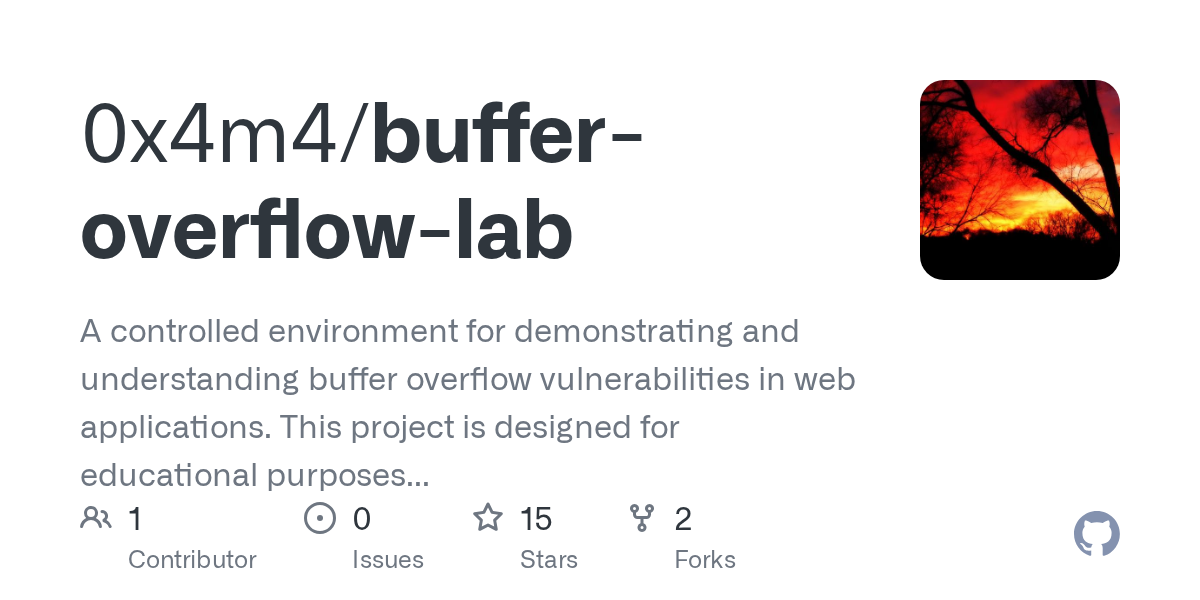buffer-overflow-lab: A Hands-On Lab for Buffer Overflow Vulnerabilities

Summary
The `buffer-overflow-lab` project provides a controlled environment to demonstrate and understand buffer overflow vulnerabilities in web applications. Designed for educational purposes, it aids in secure software development training, offering both manual testing and automated exploit scripts. This lab uses Python, Flask, and Docker to simulate real-world attack scenarios.
Repository Info
Tags
Click on any tag to explore related repositories
Introduction
The buffer-overflow-lab is an educational project by 0x4m4, designed to provide a controlled environment for demonstrating and understanding buffer overflow vulnerabilities in web applications. This lab is an invaluable resource for secure software development training, allowing users to explore how these critical flaws can be exploited. Built with Python, Flask, and Docker, it offers a practical, hands-on approach to learning cybersecurity concepts.
? Warning: This project intentionally contains vulnerable code for educational purposes. It must not be deployed in a production environment.
Installation
Getting the buffer-overflow-lab up and running is straightforward, thanks to its Dockerized setup.
Prerequisites
- Docker
- Docker Compose
- Python 3.x (for running exploit scripts)
- pip (Python package manager)
Steps
- Clone the repository:
git clone https://github.com/0x4m4/buffer-overflow-lab.git cd buffer-overflow-lab - Start the vulnerable web application:
docker-compose up --build - Install Python dependencies for the exploit script:
pip install requests - Run the exploit demonstration:
cd exploit python exploit.py
Examples
The lab includes an automated exploit script to demonstrate the vulnerability in action. Users can also interact with the web interface for manual testing. The project outlines various testing scenarios to explore different impacts of buffer overflows:
- Normal input (within buffer size)
- Boundary case testing
- Slight overflow demonstration
- Medium overflow impact
- Aggressive crash testing
This allows for a comprehensive understanding of how varying input sizes can affect application stability and security.
Why Use buffer-overflow-lab?
This project is an excellent tool for anyone looking to deepen their understanding of buffer overflow vulnerabilities and secure coding practices. Its key benefits include:
- Controlled Learning Environment: Safely experiment with exploits without risking real systems.
- Practical Demonstration: Witness buffer overflows firsthand through both a web interface and an automated script.
- Containerized Setup: Easy deployment and isolation using Docker and Docker Compose.
- Educational Focus: Specifically designed for training in secure software development.
- Concurrent Attack Simulation: Explore how multiple attack attempts can impact the application.
- Resource-Limited Environment: The container includes security measures like resource limitations, no privilege escalation, and an isolated network to ensure safety during educational use.
Links
- GitHub Repository: https://github.com/0x4m4/buffer-overflow-lab
- Author's Website: www.0x4m4.com
- License (MIT): https://github.com/0x4m4/buffer-overflow-lab/blob/main/LICENSE
- Issues Page: https://github.com/0x4m4/buffer-overflow-lab/issues